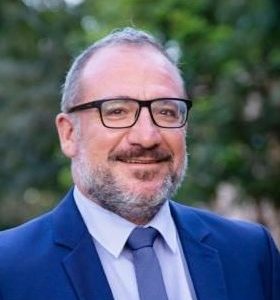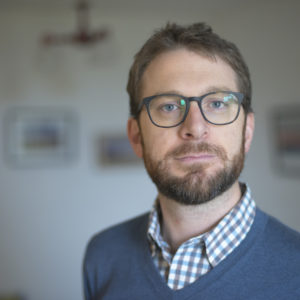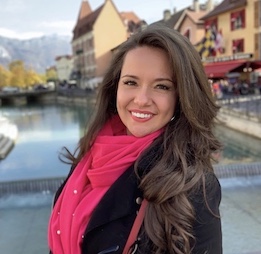Event Conference
From Data to Environmental Action | GRID-Geneva Science Day

17 Nov 2021
14:00–18:00
Venue: International Environment House II (Chem. de Balexert 7 - 9, 1219 Vernier) & Online
Organization: UNEP Global Resource Information Database Geneva
The 2021 edition of the GRID-Geneva Science Day, organized with the support of the Geneva Environment Network, aimed at providing an overview on how to move from data to environmental action.
About the Session
How can we respect planetary boundaries while striving to achieve Sustainable Development Goals? How can we track progress on the various Multilateral Environmental Agreements (MEAs)? From stopping biodiversity loss, achieving net-zero carbon emissions by 2050 to avoid runaway climate change, reducing pollution to alleviating poverty, the pathway to sustainable development grows narrower and the time to implement the drastic changes grows shorter.
Data science can support these processes by keeping the World Environment Situation under review, identifying the underlying drivers and the best solutions, modelling possible scenarios, and verifying if actions on the ground lead to positive changes for the people, the nature and the planet system. This half day event full of presentations and discussions aimed at providing an overview on how to move from data to environmental action.
Summary
To be continued.
Welcome and Introduction
Setting the Scene
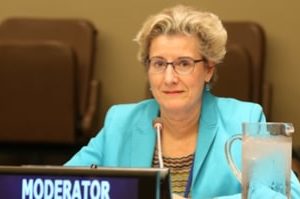
Sibylle VERMONT
Deputy Head, Global Affairs Section, Federal Office for the Environment, Switzerland
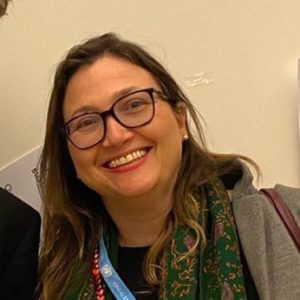
Diana RIZZOLIO (Moderator)
Coordinator, Geneva Environment Network, UNEP
Bruno POZZI | Director, Europe Office, UNEP
- Thank you to the Geneva Environment Network for supporting and organizing this event and to the Swiss Federation for the support they give to GEN and to GRID.
- If there’s one thing that we learned from COVID and from Glasgow recently is that science is the best element that we have for decision making. The decisions when they are based on solid evidence solid scientific evidence enable the political level to make better decisions. To make more convincing decisions, once the science is there, there is an important background that allows for a well-informed decision-making.
- In UNEP, we believe in strong science, in strong scientific evidence. We’ve got a normative mandate that drives us since nearly 50 years to bring environmental action into reality and to do this we use the science and the most recent data to drive our action.
- As we set the tone on (1) what matters in global environmental development, (2) why it’s important to have the environment at the center of the decision-making for the next century, and (3) how we want to achieve the SDGs, we need strong science and strong data. Geneva has an important role to play in this framework: not only because it is a UN hub where a lot of our sister agencies are headquartered alongside a strong corpus of data and of scientific evidence, but also because Geneva itself is a strong scientific hub for UNEP to create even stronger synergies, including the University of Geneva among all other partners.
- I hope that through this Science Day, we’re going to achieve a little bit more of this creating the synergies, creating the platforms and networks to get the best scientific evidence and data that will support environmental action and make the transformation that the world needs. Thank you.
Anthony LEHMANN | Professor, Institute for Environmental Sciences (ISE), University of Geneva
- It’s also a great pleasure to be here and to represent the University of Geneva. It has been a long endeavor together with this partnership, and it’s really the work that is being done here, the necessary scientific information to address the ever increasing challenges caused by environmental issues, is at the heart of the work being done at GRID. Many organizations are doing this in the world but not so many is like GRID in this very particular ecosystem of Geneva with access to all these international organization and data centers.
- I know quite well the work of GRID but each time I participate in the advisory board, I’m impressed by the progresses made. In the recent years we moved to trying all kinds of very nice potential tools to being very close to bringing about a change in the ways of informing decision makers towards creating changes in people’s behavior that we need across society.
- I will do all my best to support the continuation of this partnership and hopefully a reinforcement from the university side. When I see the work that has been done for instance on MapX, the World Environmental Situation Room, around the sand issue (Global Sand Observatory Initiative), or the Swiss Data Cube. These are all examples that of products that really matured within GRID and reach this level of influence of importance that we would like to see more and more. Thank you very much.
Sibylle VERMONT | Deputy Head, Global Affairs Section, Federal Office for the Environment, Switzerland
- I’m very happy to be with you. It is quite an honor for us to be here on this UNEP Science Day 2021. I’d like to thank UNEP, GRID and the University of Geneva. We are indeed in a very interesting partnership and I’ll explain why.
- I think what is very important is we have data, and that data is collected. But before we get to environmental action, it needs to be presented in a specific form. We are actually a first provider of data as a Federal Office: we are also an agency but we are also a consumer of data. Why do we consume data? It is because we have to take policy decisions. We have to propose to the Swiss population some proposals for new laws, new policies so that we can improve the environment. However, to do that you need to have the data in a certain representation, in a certain shape so that we can understand that. I have to say that GRID is really fantastic for presenting the data in a specific manner that is understandable but not only to the ministries of environment.
- When I read the title, I had a little question mark from data to environmental action. Actually, the actions have to be taken by everyone from the public, not just the environment sector but also from other sectors, whether it be the economic or the social sector. We are all in together, as we’ve seen it in Glasgow. Everybody’s concerned. But to be able to understand data (I come from the scientific field and 40 years ago we didn’t have the all the models you have), we really had to invent new methods and things like that put data together. It was very difficult also to represent the data the way that GRID now can do.
- We are at a fantastic point in time to be conscious. We can’t ignore what we have because we have very good data but we also have very good means to represent it. It is the innovations that GRID is bringing into the picture that makes that data so much more relevant to all of us. Thank you very much for being here and I’m looking forward to this very interesting afternoon.
Pascal PEDUZZI | Director, UNEP/GRID-Geneva
- There’s so many questions on the environment: how is climate change affecting water supply or snow coverage? Where is it burning at the moment? Is it affecting forest or protected areas? What is the size of the ozone hole? The Arctic sea ice extent, is it shrinking or not? What are those trends and what are the level of emissions of this in this country? Are they following what they signed in the Paris agreement? What can we do to limit the impact on sand mining on the environment?
- All these questions are fantastic but they request a lot of data. But many people cannot get access to the data. If I give them satellite imagery, what do they do if they don’t have the software and the knowledge on how to bring this data into something meaningful to them? That’s what the GRID center is doing, and UNEP/GRID center Geneva is the UNEP center for analytics since 1985. After 36 years we’ve been supporting UNEP in transforming data into information and knowledge to make sure that we can keep the environment into review, that we can see if the multilateral environmental agreements are being respected and if we are moving towards progress in the SDGs.
- This team of 20 data scientists with a lot of experience in transforming data into information are very essential in being the intermediaries between the data themselves and the policy decisions. We know which data can be used for what purpose because that’s the core foundation of the center. It was created for bringing the science to interface with policy and to guide the policy makers on taking and finding the narrow pathway to sustainable development.
- As we don’t have much time now with climate and biodiversity and pollution, all these thematics call for actions that is based on the best knowledge. That’s what we want to provide: providing direct access as quickly as possible, near real time information to policy makers for them to take the right decision and translating it into the right action. In other words, linking data to action.
- But we’re not doing this alone. We do that as a network, as a partnership. We are part of the One Global Partnership worldwide. We are part of the GRID network centers. We are part of the UNEP Science Division working with all the divisions and all the regions in UNEP as well as all the MEAs, the Conventions and so on.
- For this work in transforming data into information this is such a We’ve never lived in a world of so much data. We are in the era of big data and for that we rely on those data partners that work with us that do the same kind of work, with other teams worldwide. We’ve been inviting some of our friends located in Geneva, which is probably one of the few places in the world where you have the highest density of organization dealing with the environment and with data: WMO, the Group on Earth Observations, IPCC, and all the conventions. It’s being at the heart of Geneva’s environmental international organizations that give us this possibility, this position for really helping UNEP in fulfilling their mandates. We will have a glimpse today of some of the activities and some activities of our partners. Welcome to the Science Day.
1st Panel: From Data to Knowledge Sharing
We have more data than ever, however, most people do not need data, they need information and knowledge. The question is how to automatically transform raw data into useful (and used) information and knowledge and how to best share these to where it is needed. This session will hold presentations by experts on the topic, showcasing how it is possible to bring useful knowledge to act on the ground at the right time and right location. Geospatial tools, statistics visualization, interoperability are some of the tools for providing rapid access to up-to-date information to support the environmental governance and actions. The session will be followed by questions and an open discussion.
Information platforms for tracking countries’ progresses toward sustainable development
- Andrea DE BONO | Head, Data & Information Sustainability (DIES) unit, UNEP/GRID-Geneva
Remote Sensing in support of ASGM policy development, implementation and evaluation
- Kenneth DAVIS | Program Officer, UNEP Chemicals and Health Branch
- Pierre LACROIX | Head, Spatially-Explicit Environment Modelling Unit, UNEP/GRID-Geneva
ChemObs: Integrated guidance for decision making tools for the sound management of chemicals in Africa – A contribution to bridging the science to policy gap
- Pierre QUIBLIER | Programme Officer, Chemicals and Health Branch, UNEP
2nd Panel: Big Data and Artificial Intelligence for Environment
Big Earth Observations Data and Artificial Intelligence are revolutionizing the way we can generate new insights and consistent information on environmental changes at various scales. They allow unlocking the potential of digital modelling by developing digital replicas of various aspects of the Earth’s system.
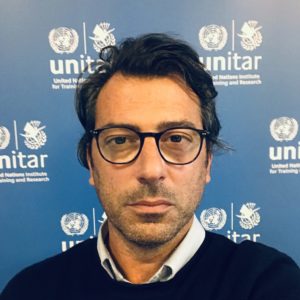
Luca DELL'ORO
Chief, Disaster Risk Management and Climate Resilience Section, UN Satellite Centre (UNOSAT)

Stephanie CHUAH (Moderator)
Project Manager, UNEP/GRID-Geneva
Applications of Earth Observation (EO) and Geospatial Information Technology (GIT) for Disaster & Climate Resilience: CommonSensing Project / AI based Flood Detection Model
- Luca DELL’ORO | Chief, Disaster Risk Management and Climate Resilience Section, UN Satellite Centre (UNOSAT)
Swiss Data Cube Observation: Open Science for Environmental Monitoring
- Gregory GIULIANI | Head, Digital Earth Unit and Swiss Data Cube Project Leader, UNEP/GRID-Geneva
Aquaculture Monitoring using AI and Satellite Images
- Diana-Denisa RODILA | Data Workflow Developer, UNEP/GRID-Geneva
3rd Panel: Data Science for Planetary Issues
Exceeding the Planetary Boundaries is placing the Earth System on the trajectory of the Anthropocene a period safe of less predictability. Can we identify the responsibilities of individual countries? How can we monitor these essential environmental variables to monitor in near real time the trends on climate and biodiversity?
Ecosystems services are often referred to as the “no regret” solutions, but what do we know about their capacity to reduce disaster risk and to support climate change adaptation? Learn about these during this panel.
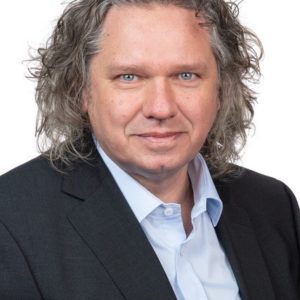
Markus BÖHM
Scientific Assistant for Digitalisation, Federal Office for the Environment, Switzerland

Sibylle VERMONT (Moderator)
Deputy Head, Global Affairs Section, Federal Office for the Environment, Switzerland
Planetary Boundaries
- Hy DAO | Head of Metadata & Socio-Economics Unit, UNEP/GRID-Geneva
GEO-Essential: Project Highlights
- Anthony LEHMANN | Professor, Institute for Environmental Sciences (ISE), University of Geneva
Opportunity mapping and science-based evidence for Eco-DRR
- Karen SUDMEIER-RIEUX | Senior Advisor, Disaster Risk Reduction, UNEP
Environment 4.0 – Simplified Data Sharing
- Markus BÖHM | Scientific Assistant for Digitalisation, Federal Office for the Environment, Switzerland
4th Panel: Building Environmental Knowledge Together
To address the complexity of environmental challenges, environmental knowledge needs to be built by various specific domain experts. Joining forces through dedicated expert networks represents one way to efficiently unify the global environmental efforts for a given thematic. This session will give the floor to four different thematic networks representatives. These networks have gained international recognition these past years and are now considered as authoritative references in their domain.
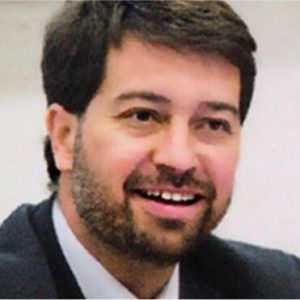
Alexandre CALDAS
Chief of Country Outreach, Technology and Innovation Branch in the Science Division, UNEP
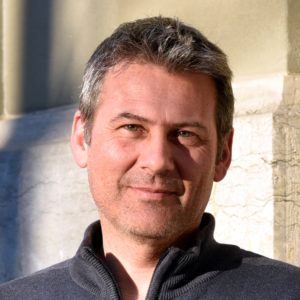
Jörg BALSIGER (Moderator)
Director, Institute and Hub for Environmental Governance and Territorial Development, University of Geneva
World Environment Situation Room (WESR) – A Worldwide One Global Partnership for Environmental Data
- Alexandre CALDAS | Chief of Country Outreach, Technology and Innovation Branch in the Science Division, UNEP
World Environment Situation Room (WESR) – New UNEP data, information and knowledge platform
- Pascal PEDUZZI | Director, UNEP/GRID-Geneva
Conclusion
Pascal PEDUZZI | Director, UNEP/GRID-Geneva
- Thank you to GEN that made this event possible. It’s a pleasure to show all this work. We do this not because of the data because we really care for the environment. Data is just a means to get somewhere. We only do the work on data because we believe that having great data helps us to find the very narrow pathways to sustainable development. Time is really upon us.
- It is also important to put facts on the table and let people know. At the same time, this is not enough. As a data and environmental scientist, I also need to know how to relay information and to trigger emotions. It’s not only the scientists that need to know this, but to trigger change across society.
- In 2006, when we organized an exhibit in Geneva on satellite imagery, we put before and after: forest to no forest, nice landscape to desert, small cities to big cities. We just depressed everybody, and nobody was inspired to take action because they were afraid.
- The following year, we did an exhibition “Reagir”, where we put the before, after, and solutions. It’s important not only to flag the problems, but also to flag solutions: what can people do at different levels? It could be about lifestyle changes for individuals, laws and regulations for policymakers, new technologies for research institutes, finance for the economy… everybody has a role to play.
- But we have such limited time, with so many emergencies to face. We need to know where to act, what to prioritize, and how we can do so. I hope the WESR is one of the tools that can help address the need of prioritizing action, and that we can provide the world with the right facts, as opposed to fake news that disorients people.
- We bring here facts, and the fact is that we have emergencies to deal with and that it’s time for action. Thank you very much for your interest in our research. There is more to show, and we will try to organize more displays of the work and know how of partners. Thank you for coming to the Science Day.
Video
In addition to the live WebEx and Facebook transmissions (Part 1, Part 2), the videos are also available on this webpage.
Documents
- Invitation
- Presentations: Introduction | Panel 1 | Panel 2 | Panel 3 | Panel 4

